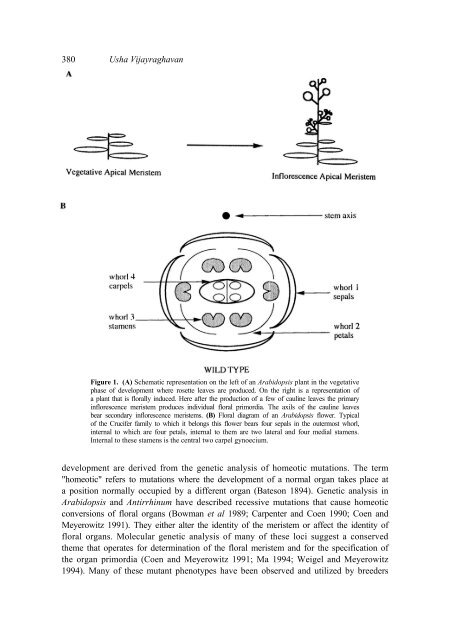Genetic regulation of flower development - Indian Academy of ...
Genetic regulation of flower development - Indian Academy of ...
Genetic regulation of flower development - Indian Academy of ...
Create successful ePaper yourself
Turn your PDF publications into a flip-book with our unique Google optimized e-Paper software.
380 Usha Vijayraghavan<br />
Figure 1. (A) Schematic representation on the left <strong>of</strong> an Arabidopsis plant in the vegetative<br />
phase <strong>of</strong> <strong>development</strong> where rosette leaves are produced. On the right is a representation <strong>of</strong><br />
a plant that is florally induced. Here after the production <strong>of</strong> a few <strong>of</strong> cauline leaves the primary<br />
inflorescence meristem produces individual floral primordia. The axils <strong>of</strong> the cauline leaves<br />
bear secondary inflorescence meristems. (B) Floral diagram <strong>of</strong> an Arabidopsis <strong>flower</strong>. Typical<br />
<strong>of</strong> the Crucifer family to which it belongs this <strong>flower</strong> bears four sepals in the outermost whorl,<br />
internal to which are four petals, internal to them are two lateral and four medial stamens.<br />
Internal to these stamens is the central two carpel gynoecium.<br />
<strong>development</strong> are derived from the genetic analysis <strong>of</strong> homeotic mutations. The term<br />
"homeotic" refers to mutations where the <strong>development</strong> <strong>of</strong> a normal organ takes place at<br />
a position normally occupied by a different organ (Bateson 1894). <strong>Genetic</strong> analysis in<br />
Arabidopsis and Antirrhinum have described recessive mutations that cause homeotic<br />
conversions <strong>of</strong> floral organs (Bowman et al 1989; Carpenter and Coen 1990; Coen and<br />
Meyerowitz 1991). They either alter the identity <strong>of</strong> the meristem or affect the identity <strong>of</strong><br />
floral organs. Molecular genetic analysis <strong>of</strong> many <strong>of</strong> these loci suggest a conserved<br />
theme that operates for determination <strong>of</strong> the floral meristem and for the specification <strong>of</strong><br />
the organ primordia (Coen and Meyerowitz 1991; Ma 1994; Weigel and Meyerowitz<br />
1994). Many <strong>of</strong> these mutant phenotypes have been observed and utilized by breeders

















